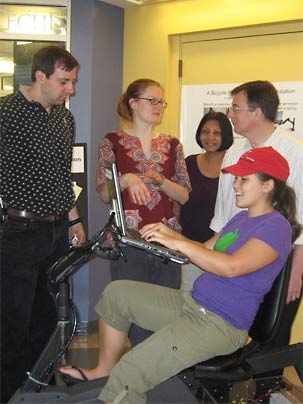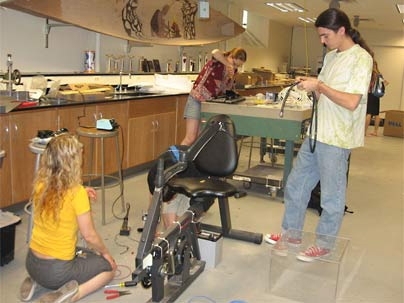MIT students have come up with a way to recharge your laptop without plugging it in. Rather than consuming electricity, you'll be burning calories--your own.
The students designed and built an exercise bicycle that uses "pedaling power" to charge a laptop computer. As the bike's instructions note, if you have trouble "squeezing in that daily exercise," you can now "multitask with no problem--[you can] bike while you work!"
The pedal-powered laptop began as a class assignment for Course 1.102, Introduction to Civil and Environmental Engineering (CEE) Design (spring 2007), when students were instructed to design and build a device that converts mechanical power into electrical power.
Class members Piotr Fidkowski, Sebastian Figari, Sara John, Kendra Johnson, Julia Kiberd, Tina Lai and Devon McCorkle teamed up to work on connecting an exercise bike to one of the computers in a dorm's Athena cluster (grouped workstations for student use). Encouraged by their instructors--CEE senior research associate John Germaine, lecturer Jessica Banks, technical instructor Stephen Rudolph and teaching assistant Matthew DeJong--team leader Johnson contacted Oliver Thomas and Laxmi Rao of Information Services and Technology (IS&T), the MIT office that oversees the Athena computers.
"We were very excited when the students came to us for guidance," said Rao, who is MIT's first IT energy coordinator and a member of the MIT Energy Initiative's (MITEI) Campus Energy Task Force. "It's the kind of collaboration that the task force would like to encourage, where MIT service providers partner with creative students to take innovative energy-saving projects built in the lab and try them out on the MIT campus."
After many hours in the lab, the students coupled a laptop donated by Dell to a much-altered exercise bike. In their design, the motion of the wheel is conveyed through a flywheel, belt and gears to a generator in the back, which charges a conventional 12-volt battery like that in a car. A charge controller regulates the electricity coming to the battery to prevent overcharging. With the aid of a 12-volt cigarette-lighter adaptor, the battery supplies electricity to the laptop, which rests on a tray atop a swiveling arm in place of the handlebars.
The bike seat is adjustable and the laptop easily moved, so a person of any height can produce an arrangement that's comfortable and ergonomic for both pedaling and computing. A cover over the wheel ensures that the rider's clothing won't get caught, and a clear plastic box encloses the electrical components but leaves them visible to curious observers.
In preliminary calculations, the students predicted that a bicyclist should be able to produce up to 75 watts continuously--far more than the 30 watts needed to power the laptop. Indeed, in an initial test drive, team member Figari easily generated 50 watts while checking his e-mail.
The pedal-powered laptop was on display last summer in N42, the building that houses IS&T. While the students originally intended to place it in an Athena cluster, they are now hoping to install it in the fitness center at the Stata Center. In moving their project from the lab to the campus, they will encounter some of the real-world challenges of taking a product to the public, from ensuring its safety and reliability to negotiating with facilities that may use it--a valuable extension of their classroom education.
This project is part of the IT Energy@MIT Initiative. Begun in March 2007 under the direction of Rao, the initiative aims to support the campus energy-saving goals of MITEI by reducing energy use for information technology across campus. Among the planned projects: an energy audit of Building N42 by a team of faculty members, graduate and undergraduate students, and personnel from MIT Facilities.
A version of this article appeared in MIT Tech Talk on November 14, 2007 (download PDF).







